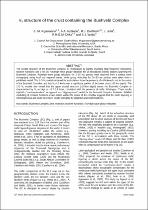JavaScript is disabled for your browser. Some features of this site may not work without it.
- ResearchSpace
- →
- Research Publications/Outputs
- →
- Conference Publications
- →
- View Item
| dc.contributor.author |
Kgaswane, EM

|
|
| dc.contributor.author |
Nyblade, AA

|
|
| dc.contributor.author |
Durrheim, RJ

|
|
| dc.contributor.author |
Julià, J

|
|
| dc.contributor.author |
Dirks, PHGM

|
|
| dc.contributor.author |
Webb, SJ

|
|
| dc.date.accessioned | 2015-08-31T06:49:00Z | |
| dc.date.available | 2015-08-31T06:49:00Z | |
| dc.date.issued | 2013-10 | |
| dc.identifier.citation | Kgaswane, EM, Nyblade, AA, Durrheim, RJ, Julià, J, Dirks, PHGM and Webb, SJ. 2013. Vs structure of the crust containing the Bushveld Complex. Proceedings of the 13th SAGA Biennial and 6th AEM Conferences, Skukuza, Kruger National Park, South Africa, 6-9 October 2013, 1-6 pp | en_US |
| dc.identifier.uri | http://hdl.handle.net/10204/8112 | |
| dc.description | Proceedings of the 13th SAGA Biennial and 6th AEM Conferences, Skukuza, Kruger National Park, South Africa, 6-9 October 2013 | en_US |
| dc.description.abstract | The crustal structure of the Bushveld Complex is investigated by jointly inverting high-frequency teleseismic receiver functions and 2–60 sec Rayleigh wave group velocities for 16 broadband seismic stations spanning the Bushveld Complex. Rayleigh wave group velocities for 2–15 sec periods were obtained from a surface wave tomography using local and regional events, while group velocities for 20–60 sec periods were taken from a published model. The 1-D V(sub3) models obtained for each station show the presence of a thickened crust in the centre of the Bushveld Complex, and that V(sub)³4.0 km/s over a significant portion of the lower crust (³30 km depth). The 1-D V(subs) models also reveal that the upper crustal structure (£10 km depth) across the Bushveld Complex is characterized by V(subs) as high as ~3.7–3.8 km/s, consistent with the presence of mafic lithologies. These results support a “continuous-sheet” as opposed to a “dipping-sheet” model for the Bushveld Complex. However, detailed modelling of receiver functions at one station within the centre of the complex suggests that the mafic layering is inhomogeneous and could have been locally disrupted by diapirism and metamorphism. | en_US |
| dc.language.iso | en | en_US |
| dc.publisher | South African Geophysical Association | en_US |
| dc.relation.ispartofseries | Workflow;12759 | |
| dc.subject | Bushveld Complex | en_US |
| dc.subject | Joint inversion | en_US |
| dc.subject | Receiver functions | en_US |
| dc.subject | Rayleigh wave group velocities | en_US |
| dc.title | V[subscript s] structure of the crust containing the Bushveld Complex | en_US |
| dc.type | Conference Presentation | en_US |
| dc.identifier.apacitation | Kgaswane, E., Nyblade, A., Durrheim, R., Julià, J., Dirks, P., & Webb, S. (2013). V[subscript s] structure of the crust containing the Bushveld Complex. South African Geophysical Association. http://hdl.handle.net/10204/8112 | en_ZA |
| dc.identifier.chicagocitation | Kgaswane, EM, AA Nyblade, RJ Durrheim, J Julià, PHGM Dirks, and SJ Webb. "V[subscript s] structure of the crust containing the Bushveld Complex." (2013): http://hdl.handle.net/10204/8112 | en_ZA |
| dc.identifier.vancouvercitation | Kgaswane E, Nyblade A, Durrheim R, Julià J, Dirks P, Webb S, V[subscript s] structure of the crust containing the Bushveld Complex; South African Geophysical Association; 2013. http://hdl.handle.net/10204/8112 . | en_ZA |
| dc.identifier.ris | TY - Conference Presentation AU - Kgaswane, EM AU - Nyblade, AA AU - Durrheim, RJ AU - Julià, J AU - Dirks, PHGM AU - Webb, SJ AB - The crustal structure of the Bushveld Complex is investigated by jointly inverting high-frequency teleseismic receiver functions and 2–60 sec Rayleigh wave group velocities for 16 broadband seismic stations spanning the Bushveld Complex. Rayleigh wave group velocities for 2–15 sec periods were obtained from a surface wave tomography using local and regional events, while group velocities for 20–60 sec periods were taken from a published model. The 1-D V(sub3) models obtained for each station show the presence of a thickened crust in the centre of the Bushveld Complex, and that V(sub)³4.0 km/s over a significant portion of the lower crust (³30 km depth). The 1-D V(subs) models also reveal that the upper crustal structure (£10 km depth) across the Bushveld Complex is characterized by V(subs) as high as ~3.7–3.8 km/s, consistent with the presence of mafic lithologies. These results support a “continuous-sheet” as opposed to a “dipping-sheet” model for the Bushveld Complex. However, detailed modelling of receiver functions at one station within the centre of the complex suggests that the mafic layering is inhomogeneous and could have been locally disrupted by diapirism and metamorphism. DA - 2013-10 DB - ResearchSpace DP - CSIR KW - Bushveld Complex KW - Joint inversion KW - Receiver functions KW - Rayleigh wave group velocities LK - https://researchspace.csir.co.za PY - 2013 T1 - V[subscript s] structure of the crust containing the Bushveld Complex TI - V[subscript s] structure of the crust containing the Bushveld Complex UR - http://hdl.handle.net/10204/8112 ER - | en_ZA |






